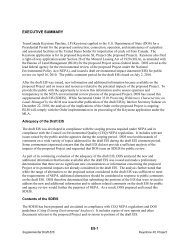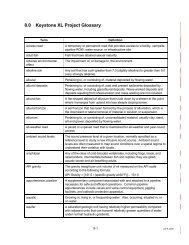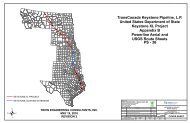2.1 Overview of the Proposed Project - Keystone XL pipeline - US ...
2.1 Overview of the Proposed Project - Keystone XL pipeline - US ...
2.1 Overview of the Proposed Project - Keystone XL pipeline - US ...
Create successful ePaper yourself
Turn your PDF publications into a flip-book with our unique Google optimized e-Paper software.
Draft Supplemental Environmental Impact Statement<strong>Keystone</strong> <strong>XL</strong> <strong>Project</strong>Pipe storage sites would be required at 30- to 80-mile intervals and contractor yards would berequired at approximately 60-mile intervals. Each pipe storage site would occupy approximately30 to 40 acres and would typically be located close to railroad sidings and as close to <strong>the</strong>proposed route as possible. Typical rail sidings would be 20 acres in size and be at existing railsidings locations. <strong>Keystone</strong> would not be building any new rail sidings. <strong>Keystone</strong> would selectexisting commercial/industrial sites or sites that were used for construction <strong>of</strong> o<strong>the</strong>r projects aspreferred sites for <strong>the</strong> storage sites.Contractor yards would occupy approximately 30 acres. Suitable sites would need to be level,without structures, and not forested, and also would need to have a minimum <strong>of</strong> two safeingress/egress points on all-wea<strong>the</strong>r county roads ra<strong>the</strong>r than busier state highways for safetyreasons. <strong>Keystone</strong> would comply with all federal, state, and local requirements prior toconstruction. Where practicable, <strong>Keystone</strong> would seek out sites that have been previouslydisturbed. <strong>Keystone</strong> would work with landowners to obtain a temporary easement for use during<strong>the</strong> period <strong>of</strong> construction.Each pipe storage site would occupy approximately 30 to 40 acres and would typically belocated close to railroad sidings. Pipe storage sites and contractor yards would be used on atemporary basis and would be reclaimed, as appropriate, upon completion <strong>of</strong> construction.<strong>2.1</strong>.5.3 Fuel Transfer StationsFuel storage sites would be established at approved contractor yards and pipe storage sites. Noo<strong>the</strong>r fuel stations would be constructed. Gasoline and diesel fuel would be transported daily byfuel trucks from <strong>the</strong> fuel transfer station to <strong>the</strong> construction area for equipment fueling. The totalfuel storage capacity would vary from yard to yard, depending on daily fuel requirements.Typically, a 2- to 3-day supply <strong>of</strong> fuel would be maintained in storage, resulting in a maximumvolume <strong>of</strong> approximately 30,000 gallons <strong>of</strong> fuel at each storage location. Each fuel storagesystem would consist <strong>of</strong> <strong>the</strong> following:• Temporary, aboveground, 10,000- to 20,000-gallon, skid-mounted tanks and/or 9,500-gallonfuel trailers;• Rigid steel piping;• Valves and fittings;• Dispensing pumps; and• Secondary containment structures.The fuel storage system would have a secondary containment structure capable <strong>of</strong> holding 110percent <strong>of</strong> <strong>the</strong> volume <strong>of</strong> <strong>the</strong> fuel storage tanks or fuel trailers. The proposed <strong>Project</strong> SPCC Planand <strong>the</strong> CMRP (see Appendix G) specify that secondary containment would be utilized for fuelstorage facilities that are not monitored or attended on a full-time basis. Similar to automotiveservice stations, <strong>the</strong>re would not be secondary containment facilities for fuel trucks that would betransferring fuel to/from <strong>the</strong> bulk storage tanks, as <strong>the</strong>se would be attended during all fueltransfer operations. As stated in <strong>the</strong> SPCC, adequate spill cleanup materials and equipmentwould be available onsite.Before receiving or <strong>of</strong>f-loading fuel, all trucks and equipment would be grounded to eliminatestatic electricity potential. The distributor would connect a petroleum-rated hose from <strong>the</strong><strong>Project</strong> Description <strong>2.1</strong>-26 March 2013











